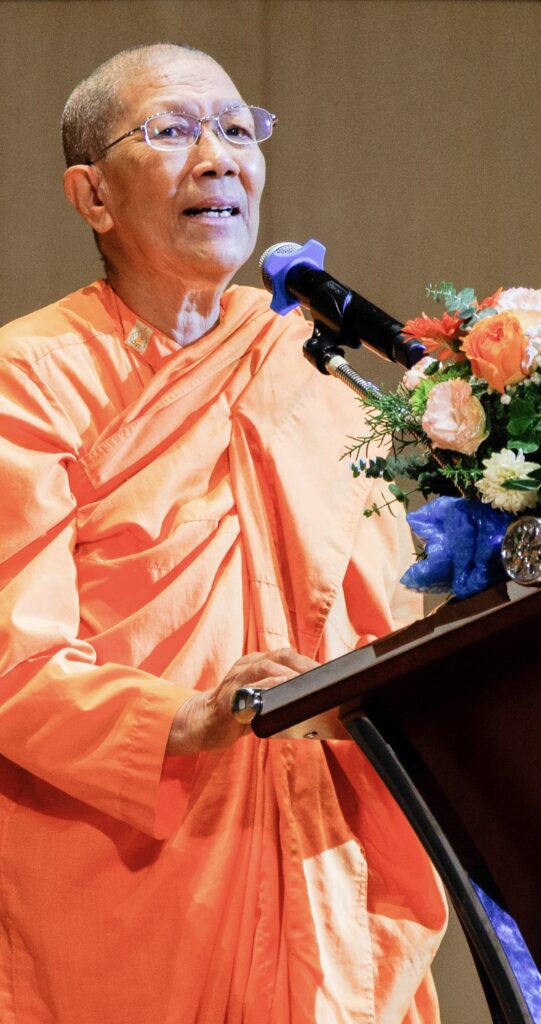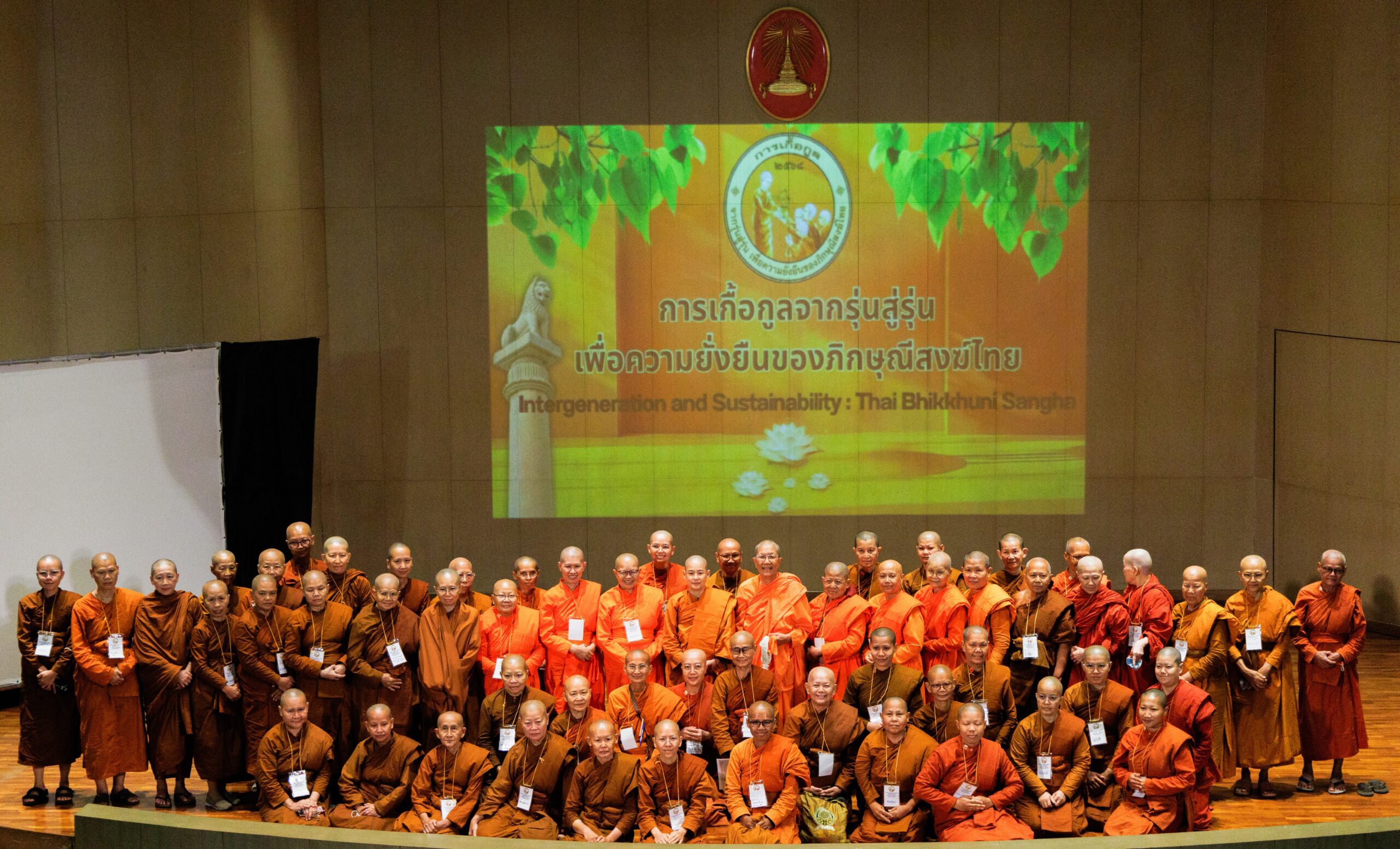An historic gathering of the Thai Bhikkhunis took place on September 27, 2025, at Chulalongkorn University in Bangkok. For the first time ever, 92 bhikkhunis (fully ordained female monastics) came together to connect and support each other. The conference title was Intergeneration and Sustainability: Thai Bhikkhuni Sangha. As the most senior bhikkhuni in Thailand, Venerable Dhammananda wanted to connect the elder generation of bhikkhunis to the younger generation. Collaboration and mutual support were uppermost in her mind. Speaking at the conference, Venerable Dhammananda said, “The key word is unity. We must be united and strongly rooted in the Dhamma Vinaya to sustain the bhikkhuni sangha in the future.”
Venerable Dhammananda began planning the conference in January of 2025. At the age of 81 she wanted to prepare the sangha to move forward beyond her own time. Associate professor Pornprapit Phoasavadi Ph.D., facilitated the event and invited all the bhikkhunis to an afternoon workshop to voice concerns in a closed session. She herself did not attend, because she wanted everyone to feel safe to express their opinions freely without her being present.
Intergenerational Support
The event showcased the importance of the Bhikkhuni Sangha as a vital foundation for preserving Buddhism in the future. The title “Intergeneration and Sustainability” aimed to raise awareness about the emergence and development of three generations of the Theravada bhikkhuni in Thailand over the past twenty-five years. The pioneers of the lineage are Venerable Voramai Kabilsingh and her daughter Venerable Dhammananda. Venerable Voramai is considered the first generation of Thai Bhikkhunis and Venerable Dhammananda is considered the second. Venerable Voramai was ordained in 1971 at Fo Guang Shang Monastery in Taiwan, in the Mahayana tradition following the Dharmaguptaka Vinaya. Her dharma name Shih Ta Tao Fa Tzu translated into Thai as “Mahabodhi Dhammacariya” of the Sakya Lineage. (Master of the Great Path in the Sakya Lineage.)
Bhikkhuni Dhammananda, who has completed twenty years of full ordination, is the Abbess of Songdhammakalyani temple, and is considered the second generation of bhikkhuni. She has dedicated her life to establish the Theravada Bhikkhuni Sangha in Thailand. She received novice ordination in 2001 in Sri Lanka in the Theravada tradition, and in 2003 received higher ordination to become the first fully ordained Thai Theravada Bhikkhuni.
History of Thai Bhikkhuni Lineage
The issue of ordination is controversial in Thailand because in the nation’s 700-year history, there had never been a Theravada bhikkhuni lineage (community of fully ordained women) prior to Venerable Dhammananda. Part of the controversy is due to an order by the Sangharaja (senior monk on the Thai Council of Elders) called the Sangha Act issued in 1929, which forbade Thai monks from ordaining women. This order is still in effect today. Venerable Voramai was a visionary because she believed that the Buddha ordained women and established the Bhikkhuni Sangha in his lifetime. She also believed that any woman who was ordained should be regarded as a bhikkhuni even though during her time in Thailand it was unheard of for a woman to be ordained.
In the early 1960’s Venerable Voramai purchased a field of rice paddies some fifty-two kilometers west of Bangkok in the city of Nakhon Pathom. From what was once a large rice field, she slowly built up her temple, Wat Songdhammakaylani, the first temple in Thailand established by and for Buddhist women. This is still Venerable Dhammananda’s Arama (monastery) today.
Venerable Voramai’s decision to receive ordination was farsighted and as a first-generation monastic, she paved the ground for her daughter, Chatsumarn Kabilsingh (Venerable Dhammananda’s lay name) to follow her example. Prior to her ordination in 2001, Venerable Dhammananda was an internationally recognized Buddhist scholar cum activist who taught Buddhist studies at Thammasat University for twenty-seven years. The value of her academic contributions as an early Buddhist feminist scholar cannot be overstated. She established the credible academic foundation upon which the current bhikkhuni revival movement in Thailand is based.
During her tenure as associate professor, she researched the original texts to confirm that the Buddha not only ordained hundreds of women as bhikkhunis in his lifetime he also confirmed their participation in the fourfold Buddhist communities. She calls the Buddha the “first feminist” because he was the first person in world religions to confirm the spiritual potential of women declaring that women can be enlightened. In addition, the Buddha expressed his intention to establish the fourfold Buddhist communities, which consist of: bhikkhus (fully ordained Buddhist monks), bhikkhunis (fully ordained Buddhist women), laymen, and laywomen. Monastic and lay participation is crucial to ensure that the Buddha’s teachings will be safeguarded and transmitted to future generations.

Venerable Dhammananda likes to use the metaphor of a chair to describe the situation in Thailand. She explains the situation this way. “You could say in my country, one leg of the chair — the fully ordained nuns — is missing. I needed to bring back the fourth leg.” Venerable Dhammananda has dedicated her life to restoring women their rightful place in Buddhism. She saw it as her responsibility to establish this missing heritage that the Buddha had granted women.
Immediately after Venerable Dhammananda’s novice ordination, a major controversy broke out in the Thai media, called the “Dhammananda controversy.” For three months she came under attack by the press, the public, and the conservative Thai clergy. The newspapers labeled her the “Rebel Monk.” At that time there were approximately 300,000 male monks in Thailand; she was the lone Theravada nun. Reflecting on that time, Venerable Dhammananda said she did not anticipate the negative reaction would be so strong. “Apart from my bed-ridden mother, I was literally standing alone. My strength came from the Buddha’s teaching, the Dhamma protects one who practices the Dhamma. And the Dhamma always wins in the end.”
The Current Generation
Twenty-five years after Venerable Dhammananda’s novice ordination, there are now 285 Bhikkhunis spread across 38 provinces in Thailand. The conference was the first time the bhikkhunis came together to meet in one large group and it was a great success. The excitement in the auditorium was palpable, everyone was inspired by the collective energy. Bhikkhunis talked about the importance of supporting and welcoming monastics from different affiliations and recommended learning more about Non-Violent Communication (NVC) to deal with conflicts/disputes as they arise.
In the afternoon, there was a private session for the Thai Bhikkhuni Sangha to meet and discuss their concerns and hopes for the future. There was universal agreement on the need to educate and train female monastics to study the Dhamma/Vinaya.
Key outcomes of the discussion
- There is an urgent need to enhance the quality of the Bhikkhuni Sangha by educating the new generation of bhikkhunis to sustain the sangha in the future. (Less than a week after the conference, a committee headed by Bhikkhuni Vajrayani of Chiang Rai met to discuss the development of an online curriculum to educate and train bhikkhunis on the Dhamma/Vinaya.)
- Sustainability can be achieved by providing opportunities for bhikkhunis to gather, exchange ideas, raise issues, and seek solutions for collective development.
- The support of the Fourfold Assembly of Buddhism — bhikkhus, bhikkhunis, laymen, and laywomen — is essential as it has been since the Buddha’s time, and continues to be a valuable model for Thai society today.
- Wat Songdhammakalyani has created a database of the number of bhikkunis in Thailand and a digital map of the location of bhikkhuni aramas. Bhikkhunis can be trained to use and maintain a data population system, as well as create a database to monitor health services for bhikkhunis including annual check-ups and vaccinations.
At the end of the day, Bhikkhuni Dhammapabha from the Southern province of Songkhla summed up her experience. Becoming emotional she said, “For years, all of us dreamed of meeting with bhikkhunis from other aramas. Our hearts rejoice in coming together. We are holding each other’s hands as we walk together on the path.”


